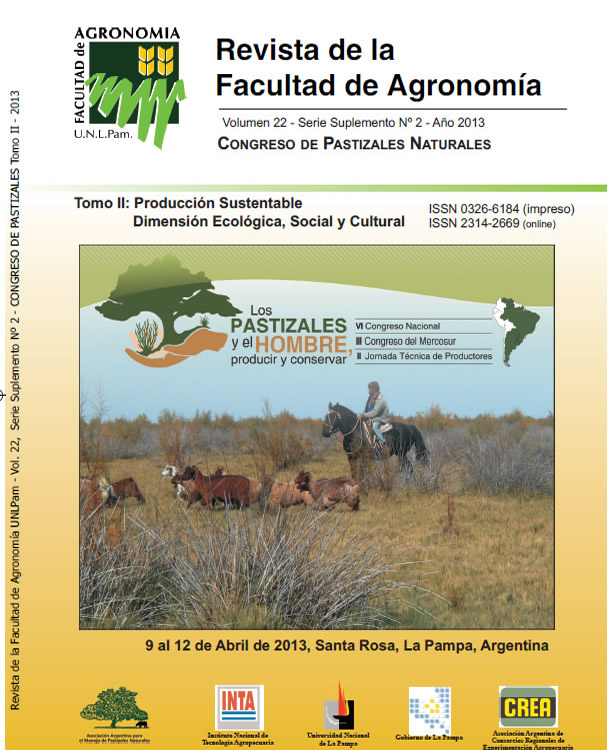Evaluation of socio-economic and cultural variables affecting grassland management in an environmental protected area in Southern Brazil
Keywords:
Diagnosis, Livestock, Sustainability, Rural populationAbstract
This work aimed to evaluate farmers’ profile at Ibirapuitã´s Envirnonmental Protected Area (EPA). The Ibirapuitã´s EPA covers the municipalities of Santana do Livramento, Alegrete, Rosário do Sul e Quaraí, RS, Brazil. Semi-structured interviews were conducted with non random samples -based in Agrarian Systems Diagnosis Analysis. Previously to the interviews a typology was created using data from relief, vegetation and soil use maps and historical documentation. Using data from these farmers´ interviews, 11 binary and 16 quantitative characteristics were selected from sampling units representing Ibirapuitã´s EPA. The relationships among these characteristics and farmers´ profiles were evaluated. Data were analyzed using the software MULTIV. The first profile could be called enterprise farmers, with larger areas, larger herds and more specialized production systems, that could be identified by higher investments in cultivated pastures or health facilities, such as pumping water at home. In the second one, called the “familial beef cattle breeders”, there were no contracted workers. This group owned smaller areas, higher stocking rates and a significant contribution of retirement salaries in their incomes. In this group, another subdivision could be found according to scholarship degree. This was indicated by a better access to information wich enhances a diversification of production for self-consumptio. It was also observed better practices in natural grasslands beef cattle raising systems. Farmers were grouped management according to the degree of cash flows and also to social and cultural characteristics influencing grassland management practices. This work demonstrate that social and cultural characteristics influences in natural grasslands management.
Downloads
References
Carvalho P.C.F., V. Fischer, D.T. Santos, Andrea, F.L.F. Quadros, Z.M.S.E.C Castilhos, A.L.G. Monteiro, C. Nabinger, T.C.M. Genro & A.V.A. Jacques. 2006. Produção animal no bioma Campos Sulinos. Rev. Bras.Zootec. / Bras. J. Anim. Sci. 35: 156-202.
Dufumier M. 2007 Projetos de Desenvolvimento Agrícola: manual para especialistas. [tradução de Vitor De Athayde Couto]. Salvador: EDUFBA.
IBGE. 2005. Produção da Pecuária Municipal. Instituto Brasileiro de Geografia e Estatística. Rio de Janeiro Disponível em www.ibge.gov.br.
Pillar V.D. 2004. MULTIV. Multivariate Exploratory Analysis, Randomization Testing and Bootstrap Resampling. Porto Alegre: Departamento de Ecologia, UFRGS. Disponível em: <http://ecoqua.ecologia.ufrgs.br/> Acesso em: 20/01/2010.
Ribeiro C.M. 2009. Estudo do modo de vida dos pecuaristas familiares da Região da Campanha do Rio Grande do Sul. Porto Alegre.
Downloads
Published
Issue
Section
License
La Editorial de la Universidad Nacional de La Pampa (EdUNLPam) exigirá a los/as autores/as la firma del siguiente documento:
La EdUNLPam lleva a cabo la publicación del artículo: (Título del Artículo) en SEMIÁRIDA Rev.Fac.Agron UNLPam ISSN 2362-4337 (impresa) ISSN 2408-4077 (en línea), del cual el/los abajo firmantes son autores de una o más partes. En el mismo acto, el/los autores entregan exclusivamente a la EdUNLPam todos sus derechos protegidos por las leyes de propiedad intelectual que rigen en la Argentina para reproducir, publicar, editar, fijar, comunicar y transmitir públicamente en cualquier formato o medio impreso o electrónico, inclusive internet, el artículo enviado a publicación e incluirlo en índices o bases de datos nacionales e internacionales. A cambio, la EdUNLPam entrega a los autores la autorización para la publicación o reimpresión con ines académicos y educativos en cualquier libro o medio de divulgación, con la sola obligación de citar el artículo original publicado en la EdUNLPam. Cada autor acuerda en que el material provisto a la EdUNLPam es un trabajo original, que no ha sido impreso o publicado en cualquier otro medio con anterioridad y que no vulnera derechos de terceros. El Primer autor tendrá la posibilidad de leer y corregir el artículo ya editado como “prueba de galera”, pero si el autor no devolviera esas correcciones de la prueba de galera dentro del tiempo especificado, el proceso de producción y publicación podrá proseguir sin la aprobación del autor. El/los autor/es no recibirán compensación monetaria de la EdUNLPam por el uso del material contenido en este artículo y asumen la responsabilidad de las opiniones vertidas en él.






.png)



22.png)



.jpg)




.jpg)
